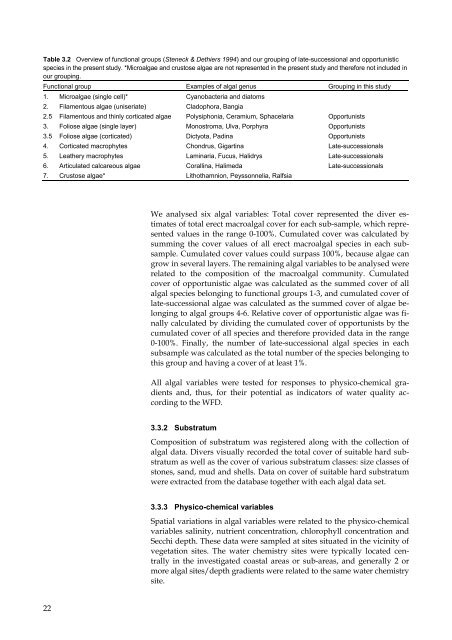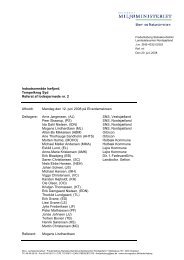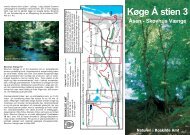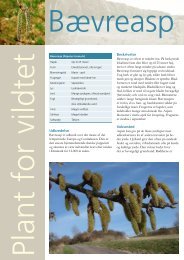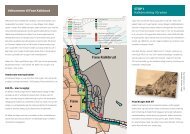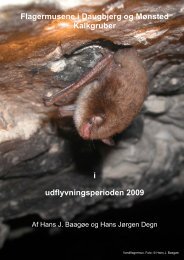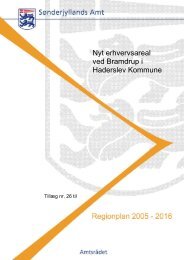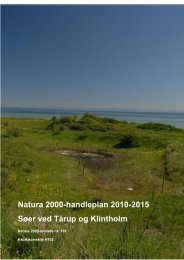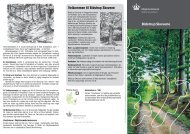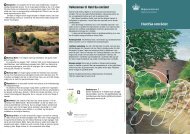Macroalgae and phytoplankton as indicators of ... - Naturstyrelsen
Macroalgae and phytoplankton as indicators of ... - Naturstyrelsen
Macroalgae and phytoplankton as indicators of ... - Naturstyrelsen
You also want an ePaper? Increase the reach of your titles
YUMPU automatically turns print PDFs into web optimized ePapers that Google loves.
Table 3.2 Overview <strong>of</strong> functional groups (Steneck & Dethiers 1994) <strong>and</strong> our grouping <strong>of</strong> late-successional <strong>and</strong> opportunistic<br />
species in the present study. *Microalgae <strong>and</strong> crustose algae are not represented in the present study <strong>and</strong> therefore not included in<br />
our grouping.<br />
Functional group Examples <strong>of</strong> algal genus Grouping in this study<br />
1. Microalgae (single cell)* Cyanobacteria <strong>and</strong> diatoms<br />
2. Filamentous algae (uniseriate) Cladophora, Bangia<br />
2.5 Filamentous <strong>and</strong> thinly corticated algae Polysiphonia, Ceramium, Sphacelaria Opportunists<br />
3. Foliose algae (single layer) Monostroma, Ulva, Porphyra Opportunists<br />
3.5 Foliose algae (corticated) Dictyota, Padina Opportunists<br />
4. Corticated macrophytes Chondrus, Gigartina Late-successionals<br />
5. Leathery macrophytes Laminaria, Fucus, Halidrys Late-successionals<br />
6. Articulated calcareous algae Corallina, Halimeda Late-successionals<br />
7. Crustose algae* Lithothamnion, Peyssonnelia, Ralfsia<br />
We analysed six algal variables: Total cover represented the diver estimates<br />
<strong>of</strong> total erect macroalgal cover for each sub-sample, which represented<br />
values in the range 0-100%. Cumulated cover w<strong>as</strong> calculated by<br />
summing the cover values <strong>of</strong> all erect macroalgal species in each subsample.<br />
Cumulated cover values could surp<strong>as</strong>s 100%, because algae can<br />
grow in several layers. The remaining algal variables to be analysed were<br />
related to the composition <strong>of</strong> the macroalgal community. Cumulated<br />
cover <strong>of</strong> opportunistic algae w<strong>as</strong> calculated <strong>as</strong> the summed cover <strong>of</strong> all<br />
algal species belonging to functional groups 1-3, <strong>and</strong> cumulated cover <strong>of</strong><br />
late-successional algae w<strong>as</strong> calculated <strong>as</strong> the summed cover <strong>of</strong> algae belonging<br />
to algal groups 4-6. Relative cover <strong>of</strong> opportunistic algae w<strong>as</strong> finally<br />
calculated by dividing the cumulated cover <strong>of</strong> opportunists by the<br />
cumulated cover <strong>of</strong> all species <strong>and</strong> therefore provided data in the range<br />
0-100%. Finally, the number <strong>of</strong> late-successional algal species in each<br />
subsample w<strong>as</strong> calculated <strong>as</strong> the total number <strong>of</strong> the species belonging to<br />
this group <strong>and</strong> having a cover <strong>of</strong> at le<strong>as</strong>t 1%.<br />
All algal variables were tested for responses to physico-chemical gradients<br />
<strong>and</strong>, thus, for their potential <strong>as</strong> <strong>indicators</strong> <strong>of</strong> water quality according<br />
to the WFD.<br />
3.3.2 Substratum<br />
Composition <strong>of</strong> substratum w<strong>as</strong> registered along with the collection <strong>of</strong><br />
algal data. Divers visually recorded the total cover <strong>of</strong> suitable hard substratum<br />
<strong>as</strong> well <strong>as</strong> the cover <strong>of</strong> various substratum cl<strong>as</strong>ses: size cl<strong>as</strong>ses <strong>of</strong><br />
stones, s<strong>and</strong>, mud <strong>and</strong> shells. Data on cover <strong>of</strong> suitable hard substratum<br />
were extracted from the datab<strong>as</strong>e together with each algal data set.<br />
3.3.3 Physico-chemical variables<br />
Spatial variations in algal variables were related to the physico-chemical<br />
variables salinity, nutrient concentration, chlorophyll concentration <strong>and</strong><br />
Secchi depth. These data were sampled at sites situated in the vicinity <strong>of</strong><br />
vegetation sites. The water chemistry sites were typically located centrally<br />
in the investigated co<strong>as</strong>tal are<strong>as</strong> or sub-are<strong>as</strong>, <strong>and</strong> generally 2 or<br />
more algal sites/depth gradients were related to the same water chemistry<br />
site.<br />
22


